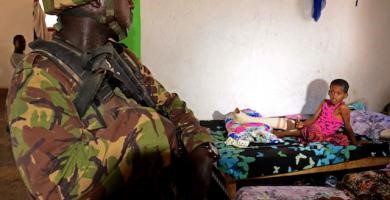 Recent fighting in the southern Somali city of Kismayo between militias led by warlords Ahmed Madobe and Barre Hiraale, both of whom claim the presidency of Jubaland territory, could unravel security gains in the region and allow the Islamist militant group al Shabaab to reassert itself. Meanwhile, Kenya, Ethiopia and Somalia are pursuing their own interests in the region, conducting separate security operations and lending their support to different clans and militias. In the long term, stability in southern Somalia will depend on continued financial and military commitment from Kenya and Ethiopia.
Recent fighting in the southern Somali city of Kismayo between militias led by warlords Ahmed Madobe and Barre Hiraale, both of whom claim the presidency of Jubaland territory, could unravel security gains in the region and allow the Islamist militant group al Shabaab to reassert itself. Meanwhile, Kenya, Ethiopia and Somalia are pursuing their own interests in the region, conducting separate security operations and lending their support to different clans and militias. In the long term, stability in southern Somalia will depend on continued financial and military commitment from Kenya and Ethiopia.
The federal government of Somalia has yet to establish control of regions outside of Mogadishu and a few key towns in central Somalia. Kismayo, the largest city and trade port as well as the capital of Jubaland, remains under the control of militias backed by either Kenya or Ethiopia, although Somalia wants to install political leadership over the region and gain access to revenue from Kismayo's port. At the root of these frictions are Somali clan politics in the south and the regional rivalry between Ethiopia and Kenya.
For Mogadishu, it is important to ensure that the Ogaden ethnic group, which makes up the dominant clan structure of southern Somalia, does not become too powerful in Kismayo. If this happens, al Shabaab could be able to manipulate clan politics by gathering the support of smaller clans that oppose the Ogaden -- as it did when it initially pushed Ahmed Madobe's Ras Kamboni Brigades out of Kismayo in 2011. Al Shabaab is split between transnational and national factions, but its support base is the politically and economically marginalized clans in southern rural areas.
Kenya, which borders Somalia to the southwest, has made it clear it is not satisfied with Somalia's security accomplishments in the border areas. Through its military operations and cooperation with local militias such as the Ras Kamboni Brigades, Nairobi is attempting to establish a buffer either through a subservient regime that Kenya can directly control or one that runs its own security policy independent of Mogadishu.
A Kenyan-supported Ogaden administration is not in Ethiopia's best interest. An Ogaden-dominated Jubaland could be a source of support for the Ogaden within Ethiopia or any Muslim insurgency group at odds with the Ethiopian regime. To prevent this, Ethiopia is supporting Marehan proxies, such as Barre Hiraale's militia. This clan political dynamic is eternal in Somalia, but clan fault lines have become even more pronounced since the fall of the Siad Barre dictatorship in 1991. Barre was able to manage it by creating an alliance consisting of the Marehan, Ogaden and Dhulbahante Darod sub-clans. Since 1991, however, there has been no solidifying force to maintain the alliance.
Kenya first proposed the creation of a Jubaland administration several years ago, viewing southern Somalia as a buffer zone against any threats emanating from Somalia's insecurity. Before World War I, Jubaland was a part of Kenya. In recent years, cross-border raids and kidnappings increased in frequency, prompting Kenya to conducts its first military operation outside its borders, with the goal of pushing the militants back and limiting the fallout in Kenya.
The diverging priorities of Ethiopia and Kenya highlight the rivalry of East Africa's two biggest economies and countries. Kenya is the largest and most advanced economy in the region and Nairobi has established itself as the gateway to East Africa. However, Ethiopia is the traditional regional power, with twice the population, a comparably sized economy and a much larger military. With economic prospects in Ethiopia looking more favorable, Kenya risks being passed by Ethiopia within the next few years to become East Africa's dominant economic power. However, at this point, the two countries' competition may weaken the security gains made against al Shabaab in the region.
Courtesy : Stratfor (www.stratfor.com)